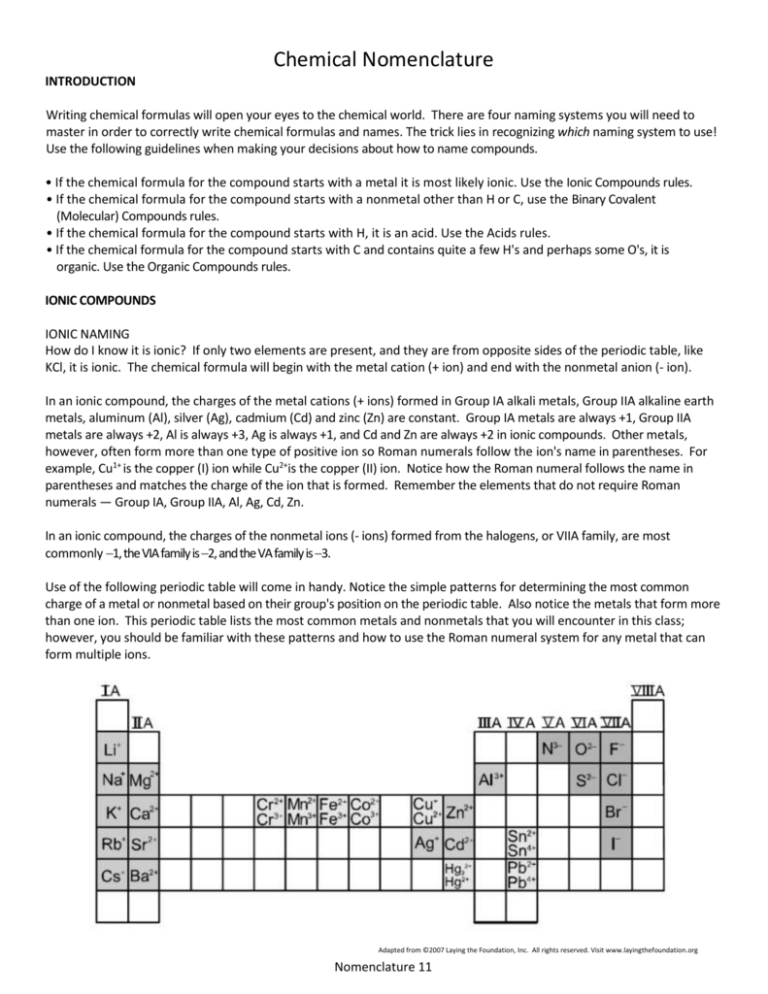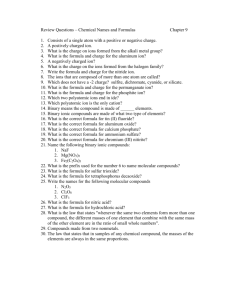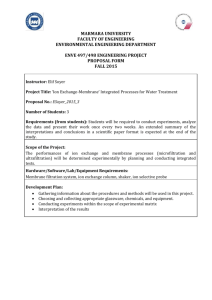
Chemical Nomenclature
INTRODUCTION
Writing chemical formulas will open your eyes to the chemical world. There are four naming systems you will need to
master in order to correctly write chemical formulas and names. The trick lies in recognizing which naming system to use!
Use the following guidelines when making your decisions about how to name compounds.
• If the chemical formula for the compound starts with a metal it is most likely ionic. Use the Ionic Compounds rules.
• If the chemical formula for the compound starts with a nonmetal other than H or C, use the Binary Covalent
(Molecular) Compounds rules.
• If the chemical formula for the compound starts with H, it is an acid. Use the Acids rules.
• If the chemical formula for the compound starts with C and contains quite a few H's and perhaps some O's, it is
organic. Use the Organic Compounds rules.
IONIC COMPOUNDS
IONIC NAMING
How do I know it is ionic? If only two elements are present, and they are from opposite sides of the periodic table, like
KCl, it is ionic. The chemical formula will begin with the metal cation (+ ion) and end with the nonmetal anion (- ion).
In an ionic compound, the charges of the metal cations (+ ions) formed in Group IA alkali metals, Group IIA alkaline earth
metals, aluminum (Al), silver (Ag), cadmium (Cd) and zinc (Zn) are constant. Group IA metals are always +1, Group IIA
metals are always +2, Al is always +3, Ag is always +1, and Cd and Zn are always +2 in ionic compounds. Other metals,
however, often form more than one type of positive ion so Roman numerals follow the ion's name in parentheses. For
example, Cu1+ is the copper (I) ion while Cu2+is the copper (II) ion. Notice how the Roman numeral follows the name in
parentheses and matches the charge of the ion that is formed. Remember the elements that do not require Roman
numerals — Group IA, Group IIA, Al, Ag, Cd, Zn.
In an ionic compound, the charges of the nonmetal ions (- ions) formed from the halogens, or VIIA family, are most
commonly 1, the VIA family is 2, and the VA family is 3.
Use of the following periodic table will come in handy. Notice the simple patterns for determining the most common
charge of a metal or nonmetal based on their group's position on the periodic table. Also notice the metals that form more
than one ion. This periodic table lists the most common metals and nonmetals that you will encounter in this class;
however, you should be familiar with these patterns and how to use the Roman numeral system for any metal that can
form multiple ions.
Adapted from ©2007 Laying the Foundation, Inc. All rights reserved. Visit www.layingthefoundation.org
Nomenclature 11
It is essential that you memorize the common polyatomic ions. Polyatomic ions are groups of atoms that behave as a unit
and possess an overall charge. If more than one copy of a polyatomic ion is needed to create a chemical formula, the ion
must be enclosed in parentheses before adding the subscripts. You need to know their names, formulas and charges.
When you memorize the list of polyatomic ions, you will find that chemical nomenclature becomes a very easy topic.
PRACTICE, PRACTICE, PRACTICE!
The polyatomic ions that end with –ate and with charges less than negative one, meaning ions with charges of 2, 3, etc.,
can have an H added to them to form new polyatomic ions. For each H added the charge is increased by a +1. For instance,
CO32-, the carbonate ion, can have an H added and become HCO31-, the hydrogen carbonate ion. Since the phosphate polyatomic ion,
PO43-has a 3 charge, you can add one hydrogen to from the hydrogen phosphate ion, HPO42-, or two hydrogen ions to create the dihydrogen
phosphate ion, H2PO41-. If you continue adding hydrogen ions until your reach neutral, you’ve made an acid! That means you will need to see
the Naming Acids rules.
In order to name ionic compounds, first name the ions.
Naming positive ions: Metals commonly form cations.
• Monatomic positive ions in Group A are named by simply writing the name of the metal from which it is derived.
Examples: Al3+ is the aluminum ion, Li1+ is the lithium ion.
• Metals often form more than one type of positive ion so Roman numerals (in parentheses) follow the ion's name.
Examples: Cu1+ is the copper (I) ion, Cu2+ is the copper (II) ion. Remember the exceptions — Group IA, Group IIA,
Al, Ag, Cd, Zn.
1+
• NH4 is the ammonium ion. It is the most common positive polyatomic ion that you will encounter.
Naming negative ions: Nonmetals commonly form anions ( ions). Most of the polyatomic ions are also negatively-charged.
• Monatomic negative ions are named by adding the suffix -ide to the stem of the nonmetal's name. Group VII A,
the Halogens are called the halides.
Examples: Cl1 is the chloride ion, O2- is the oxide ion.
• Polyatomic anions are given the names of the polyatomic ion. You must memorize these as instructed.
Examples: NO2-1 is the nitrite ion
Naming the Compound: The + ion (cation) name is given first followed by the name of the negative
ion (anion). Remember, to include the Roman numeral that indicates a metal's charge for the many metals that have
more than one oxidation state. No prefixes are used in naming ionic compounds.
Examples: NaCl is named sodium chloride, (NH4)2SO4 is named ammonium sulfate.
IONIC FORMULA WRITING
Naming is the trickiest part! Once you have been given the name, the formula writing is easy as long as you have
memorized the formulas and charges of the polyatomic ions. Roman numerals are your friend; they tell you the charge of
the metal ions that can have more than one oxidation state and thus form positive ions with different charges. Remember
that Group IA, Group IIA, Al, Ag, Cd, & Zn are usually not written with a Roman numeral; you must know their charges. The
most important thing to remember is that, the sum of the charges must add up to zero in order to form a neutral
compound. The crisscross method is very useful—the charge on one ion becomes the subscript on the other. If you use
this method, you must always check to see that the subscripts are in their lowest whole number ratio! Here are some
examples:
→
potassium oxide
K1+ O2-
K1
iron (III) chlorate
Fe3+ ClO31-
→
tin (IV) sulfite
Sn4+ SO32-
→
zinc acetate
Zn2+ C2H3O21-
→
K2O
ClO31
→
Fe(ClO3)3
SO32
→
Sn2(SO3)4
O2
Fe3
Sn4
→
Zn2
C2H3O21
→
→
Sn(SO3)2
Zn(C2H3O2)2
Adapted from ©2007 Laying the Foundation, Inc. All rights reserved. Visit www.layingthefoundation.org
Nomenclature 12
BINARY COVALENT (MOLECULAR) COMPOUNDS
BINARY COVALENT (MOLECULAR) NAMING
How will I know it is a covalent (molecular) compound? (“Covalent” and “molecular” are used interchangeably). The
chemical formula will contain a combination of nonmetals, both lying near each other on the periodic table. No
polyatomic ions will be present. Use the following set of prefixes when naming covalent (molecular) compounds.
Naming the Compound: Use prefixes to indicate the number of atoms of each element. Don't forget the -ide ending. If the
second element's name begins with a vowel, then the "a" at the end of the prefix is usually dropped. N2O5 is dinitrogen
pentoxide not dinitrogen pentaoxide. PCl5 is phosphorous pentachloride not phosphorous pentchloride.
BINARY COVALENT (MOLECULAR) FORMULA WRITING
The prefixes of a molecular compound make it really easy to write the formula since the prefix tells you how many atoms
are present for each element. Here are some examples:
carbon monoxide
CO
(No prefix on first element means one, mono- means one)
carbon dioxide
CO2
(No prefix on the first element means one, di- means two)
dinitrogen tetroxide
N2O4
(di- means two, tetra- means four)*note the removal of the “a” from tetra-
ACIDS
ACID NAMING
How do I know it is an acid? The compound's formula begins with a hydrogen, H, and water doesn’t count. Naming acids is
extremely easy, if you know your polyatomic ions. There are three rules to follow:
• H + element: If the acid has only one element following the H, then use the prefix hydro- followed by the element's
root name and an -ic ending.
Example: HCl is hydrochloric acid. HF is hydrofluoric acid. H2S is hydrosulfuric acid. When you see an acid name
beginning with "hydro", think "Caution, element approaching!" (HCN is an exception since it is a polyatomic ion
without oxygen, and it is named hydrocyanic acid).
• H + -ate polyatomic ion: If the acid has an "-ate" polyatomic ion after the H, then it makes an "-ic" acid.
Example: H2SO4is sulfuric acid.
• H + -ite polyatomic ion: If the acid has an "-ite" polyatomic ion after the H, then it makes an "-ous" acid.
Example: H2SO3 is sulfurous acid.
Adapted from ©2007 Laying the Foundation, Inc. All rights reserved. Visit www.layingthefoundation.org
Nomenclature 13
ACID FORMULA WRITING
When writing formulas for acids you must have enough H+ added to the anion to make the compound neutral. Also note
that -ate and -ite polyatomic ions contain oxygen so, their acids are often referred to as oxyacids. See above examples.
NAMING ORGANIC COMPOUNDS
How do I know it is organic? The chemical formula will start with a C followed by hydrogens and may even contain some
oxygen. Most of the organic carbons you will encounter will be either hydrocarbons or alcohols. These are the simplest of
all to name. Memorize the list of prefixes in table found below. The prefixes correspond to the number of carbons present
in the compound and will be the stem for each organic compound. Notice that the prefixes are standard geometric prefixes
once you pass the first four carbons. This silly statement will help you remember the order of the first four prefixes since
they are not ones you are familiar with: "Me Eat Peanut Butter." This corresponds to meth-, eth-, prop-, and but- which
correspond to 1, 2, 3, and 4 carbons, respectively. Now that we have a stem, we need an ending. There are three common
hydrocarbon endings that you will need to know as well as the ending for alcohols. The ending changes depending on the
structure of the molecule.
• -ane - alkane (all single bonds & saturated) CnH2n+2; The alkanes are referred to as saturated hydrocarbons
because they contain only single bonds and thus, the maximum number of hydrogen atoms.
• -ene = alkene (contains one double bond & unsaturated) CnH2n; The alkenes are referred to as unsaturated
hydrocarbons because a pair of hydrogens have been removed to create the double bond.
• -yne alkyne (contains one triple bond & unsaturated) CnH2n-2; The alkynes are also referred to as unsaturated, because two
pairs of hydrogens have been removed to create the triple bond. The term polyunsaturated means that the
compound contains more than one double or triple bond.
• -ol - alcohol (one H is replaced with a hydroxyl group, -OH group, to form an alcohol) CnH2n+1OH; Do not be
fooled—this looks like a hydroxide ion, but is not! It does not make this hydrocarbon an alkaline or basic
compound. Do not name these as a hydroxide! C2H6 is ethane while C2H5OH is ethanol.
Table: Organic Nomenclature
Adapted from ©2007 Laying the Foundation, Inc. All rights reserved. Visit www.layingthefoundation.org
Nomenclature 14
Ionic Nomenclature
Common Monatomic Ions
Use the periodic table and list below to help you practice for your nomenclature quizzes. Remember that although you
will be unable to use this periodic table and reference list, you will get to use a clean, regular periodic table for all
quizzes and exams.
Common Metals that form MORE THAN ONE
Monatomic Cation
Formula
Name
Name (OLD)
Cr2+
chromium(II) or
chromous
Cr3+
chromium(III) or
chromic
Co2+
Co3+
cobalt(II)
cobalt(III)
or
or
cobaltous
cobaltic
Cu1+
Cu2+
copper(I)
copper(II)
or
or
cuprous
cupric
Fe2+
Fe3+
iron(II)
iron(III)
or
or
ferrous
ferric
Pb2+
Pb4+
lead(II)
lead(IV)
or
or
plumbous
plumbic
Mn2+
Mn3+
Mn4+
manganese(II) or
manganese(III) or
manganese(IV)
manganous
manganic
Hg22+
Hg2+
mercury(I)*
mercury(II)
or
or
mercurous
mercuric
Sn2+
Sn4+
tin(II)
tin(IV)
or
or
stannous
stannic
Formula
H1+
Li1+
Na1+
K1+
Rb1+
Cs1+
Ag1+
Mg2+
Ca2+
Sr2+
Ba2+
Zn2+
Cd2+
Al3+
Common Metals that form only ONE
Monatomic Cation
Name
hydrogen ion
lithium ion
sodium ion
potassium ion
rubidium ion
cesium ion
silver ion
magnesium ion
calcium ion
strontium ion
barium ion
zinc ion
cadmium ion
aluminum ion
Common Nonmetals that form only ONE
Monatomic Anion
Formula
Name
H1hydride ion
1F
fluoride ion
Cl1chloride ion
Br1bromide ion
1I
iodide ion
O2oxide ion
S2sulfide ion
3N
nitride ion
P3phosphide ion
Adapted from ©2007 Laying the Foundation, Inc. All rights reserved. Visit www.layingthefoundation.org
Nomenclature 15
+1 CHARGE
ION
NAME
NH41+
ammonium*
H3O1+
hydronium
Hg22+
mercury (I)
Common Polyatomic Ions
-1 CHARGE
-2 CHARGE
-3 CHARGE
ION
NAME
ION
NAME
ION
NAME
dihydrogen
hydrogen
H2PO31HPO32PO33phosphite
phosphite
phosphite
dihydrogen
hydrogen
H2PO41HPO42PO43phosphate*
phosphate
phosphate
hydrogen
HCO31CO32carbonate* PO23- hypophosphite
carbonate*
hydrogen
HSO31SO32sulfite*
AsO33arsenite
sulfite
hydrogen
HSO41SO42sulfate*
AsO43arsenate
sulfate
NO21nitrite*
S2O32- thiosulfate
NO31nitrate*
SiO32silicate
12OH
hydroxide*
C2
carbide
C2H3O21CH3COO1-
CrO21CN1CNO1CNS1O21MnO41ClO1ClO21ClO31ClO41BrO1BrO21BrO31BrO41IO1IO21IO31IO41AlO21N31-
acetate*
C2O42-
oxalate
chromite
cyanide*
cyanate
thiocyanate
superoxide
CrO42Cr2O72-
chromate*
C4H4O62-
tartrate
molybdate
peroxide
disulfide
permanganate*
MoO42O22S22-
dichromate*
hypochlorite*
chlorite*
chlorate*
perchlorate*
hypobromite
bromite
bromate
perbromate
hypoiodite
iodite
iodate
periodate
aluminate
azide
*Ions that appear on the STAAR Chemistry Reference Chart.
Vocabulary
Ion- an atom or group of atoms that has gained or lost electrons
Monatomic ion- a single atom that has gained or lost electrons and has a charge
Polyatomic ion- a group of covalently bound atoms that has an overall charge
Anion- a negatively charged ion
Cation- a positively charged ion
Oxidation number- hypothetical charge a covalently bound atom would have IF its bonds were ionic
Acid- a compound that donates H1+ ions during a reaction
Ionic Compound- a compound made of positively and negatively charged ions
Covalent (Molecular) Compound- a compound held together by shared pairs of electrons
Hydrocarbon- a compound composed of carbon and hydrogen
Nomenclature 16
-4 CHARGE
ION
NAME
P2O74-
pyrophosphate


